Key to workers of subfamilies and genera of ants known from Egypt
| The Ants
of Egypt Key to workers of subfamilies and genera of ants known from Egypt |
Key to workers - with subkey sections to Genera where more than one
| 1 | 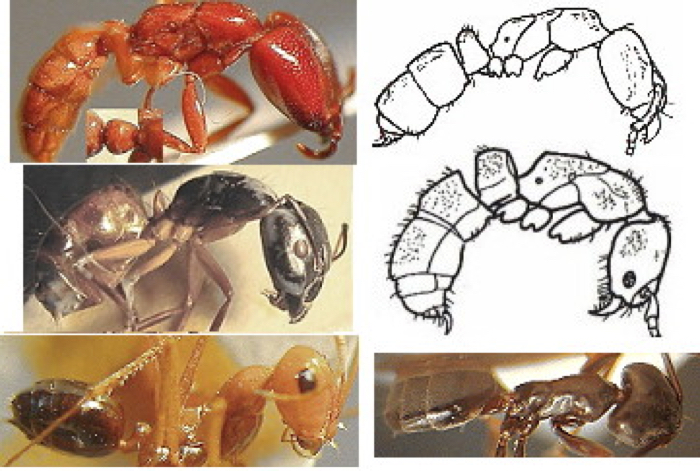 Body with a single reduced or isolated segment (the
petiole) between alitrunk and gaster; first gastral segment either
entirely confluent with the second or separated from it only by a
narrow girdling constriction, and if the latter then the first gastral
segment is not markedly reduced in size. Body with a single reduced or isolated segment (the
petiole) between alitrunk and gaster; first gastral segment either
entirely confluent with the second or separated from it only by a
narrow girdling constriction, and if the latter then the first gastral
segment is not markedly reduced in size. |
2 |
| -- | 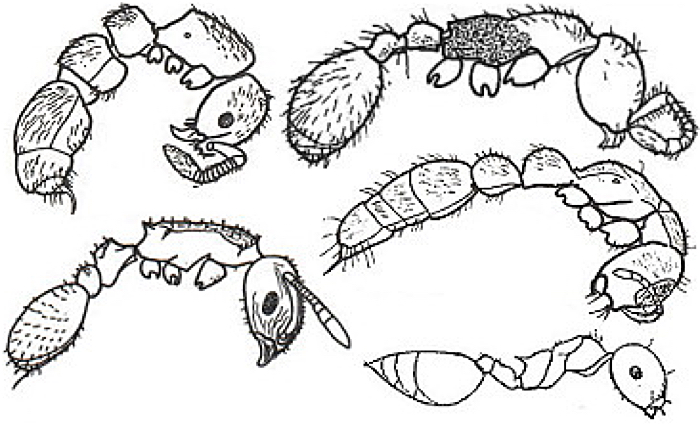 Body with 2 reduced or isolated segments (the petiole and
postpetiole) between alitrunk and gaster; either both segments are much
reduced, or the second is somewhat larger than the first, and if the
latter then the postpetiole is distinctly smaller than the first
gastral segment and separated from it by an extensive, deep girdling
constriction. Body with 2 reduced or isolated segments (the petiole and
postpetiole) between alitrunk and gaster; either both segments are much
reduced, or the second is somewhat larger than the first, and if the
latter then the postpetiole is distinctly smaller than the first
gastral segment and separated from it by an extensive, deep girdling
constriction. |
6 |
| 2 | 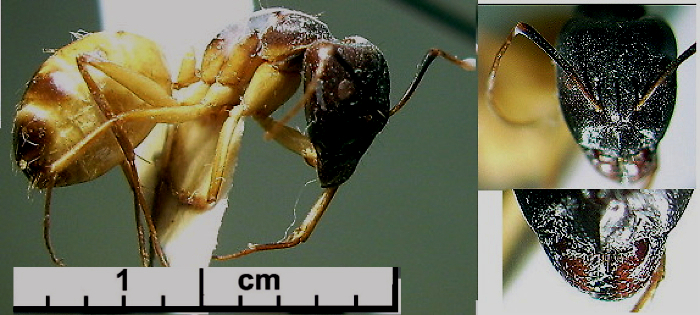 Apex of gaster with a semicircular to circular acidopore
formed from the hypopygium, this structure often projecting as a nozzle
and fringed with setae; sometimes the acidopore is concealed by a
projection of the pygidium, but if so the antennal insertions are
located well behind the posterior clypeal margin; sting absent,
replaced by an acid-projecting system of which the acidopore is the
orifice. Apex of gaster with a semicircular to circular acidopore
formed from the hypopygium, this structure often projecting as a nozzle
and fringed with setae; sometimes the acidopore is concealed by a
projection of the pygidium, but if so the antennal insertions are
located well behind the posterior clypeal margin; sting absent,
replaced by an acid-projecting system of which the acidopore is the
orifice. |
FORMICINAE - ten Genera - subkey F |
| -- | Apex of gaster with hypopygium lacking an acidopore; sting present or absent; when present it is usually visible but when reduced or vestigial (or present but completely retracted) the hypopygium forms a smooth posterior margin (not modified as above), and the antennal sockets abut the posterior margin of the clypeus. | 3 |
| 3 |  Pedicel
with a very broad connection to the gaster, so that petiole is without
a distinct posterior face Pedicel
with a very broad connection to the gaster, so that petiole is without
a distinct posterior face |
AMBLYOPONINAE - not recorded from Egypt but possibly present - Genus Stigmatomma |
| -- | Pedicel with a narrow connection to the gaster, so that petiole has a distinct posterior face | 4 |
| 4 | 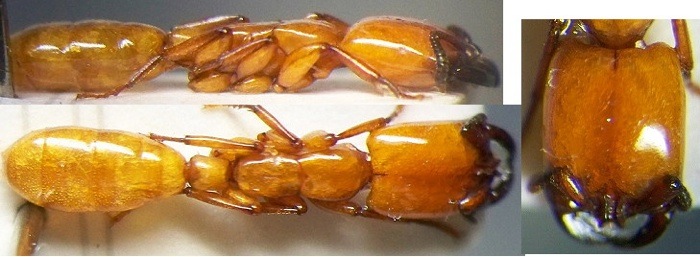 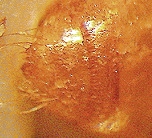 Pygidium armed with a
single pair of short, posterolaterally situated or a marginal row of
short spines or peg-like; gastral spiracles 3-5 (= abdominal spiracles
5-7) exposed, not overlapped nor concealed by the tergites of the
preceding segments; metapleural gland orifice overhung and concealed
from above by a cuticular lip or flange, the latter extending obliquely
upwards and forwards on the metapleuron as a rim or ridge; helcium
sternite convex and bulging ventrally, visible in profile; propodeal
spiracle high on side and situated far forward on the sclerite, the
spiracular orifice subtended by a longitudinal impression; propodeal
lobes absent; armament of pygidium consisting solely of a single pair
of posteriorly directed short spines that are situated
posterolaterally; promesonotal suture always distinct. Pygidium armed with a
single pair of short, posterolaterally situated or a marginal row of
short spines or peg-like; gastral spiracles 3-5 (= abdominal spiracles
5-7) exposed, not overlapped nor concealed by the tergites of the
preceding segments; metapleural gland orifice overhung and concealed
from above by a cuticular lip or flange, the latter extending obliquely
upwards and forwards on the metapleuron as a rim or ridge; helcium
sternite convex and bulging ventrally, visible in profile; propodeal
spiracle high on side and situated far forward on the sclerite, the
spiracular orifice subtended by a longitudinal impression; propodeal
lobes absent; armament of pygidium consisting solely of a single pair
of posteriorly directed short spines that are situated
posterolaterally; promesonotal suture always distinct. |
DORYLINAE - one Genus Dorylus |
| -- | Pygidium and hypopygium both unarmed; pygidium transversely convex and rounded, lacking either a posterolateral pair of short spines or a marginal row of short spines or peg-like teeth; hypopygium with its lateral margins smooth and without spines. | 5 |
| 5 |  Sting vestigial or
absent, in any case not visible without dissection. Tergite of helcium
with an extensive U- or V-shaped emargination dorsally in its anterior
margin (visible if gaster slightly depressed). Sting vestigial or
absent, in any case not visible without dissection. Tergite of helcium
with an extensive U- or V-shaped emargination dorsally in its anterior
margin (visible if gaster slightly depressed). |
DOLICHODERINAE - three Genera - subkey D |
| -- | 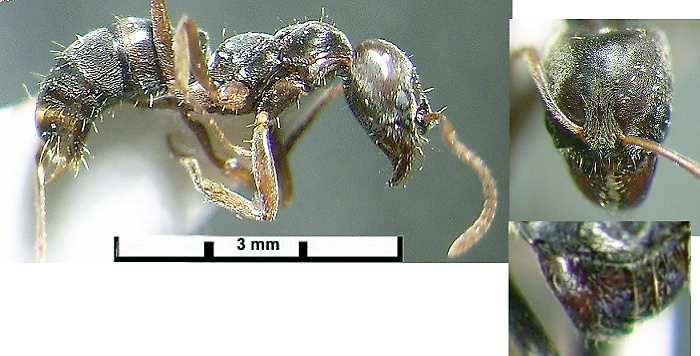 Sting present and
functional, often projecting in dead specimens; in many species the
sting shaft is visible through the cuticle of the gastral apex
ventrally even when fully retracted; tergite of helcium entire, its
anterior margin dorsally without a U- or V-shaped emargination;
pretarsal claws with a tooth, or sometimes several teeth, on the inner
curvature behind the apical point; frontal lobes present and
horizontally aligned, partially to completely concealing the antennal
sockets; antennal sockets a notable distance behind the anterior margin
of the head, the clypeus well developed in front of them; spiracles of
gastral segments 4 and 5 concealed Sting present and
functional, often projecting in dead specimens; in many species the
sting shaft is visible through the cuticle of the gastral apex
ventrally even when fully retracted; tergite of helcium entire, its
anterior margin dorsally without a U- or V-shaped emargination;
pretarsal claws with a tooth, or sometimes several teeth, on the inner
curvature behind the apical point; frontal lobes present and
horizontally aligned, partially to completely concealing the antennal
sockets; antennal sockets a notable distance behind the anterior margin
of the head, the clypeus well developed in front of them; spiracles of
gastral segments 4 and 5 concealed |
PONERINAE - four Genera- subkey P |
| -- | Pedicel of two segments distinctly separated from the gaster | -- |
| 6 | Eyes absent or at most represented by a single ommatidium or small, featureless blister. | 7 |
| -- | Eyes present and conspicuous, with many distinct ommatidia . | 8 |
| 7 | 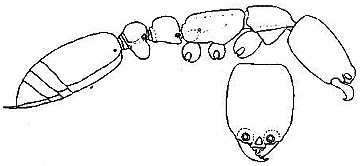 Promesonotal suture present and
very conspicuous in dorsal view; usually deeply impressed and always
freely flexible in fresh specimens; pygidium large and conspicuous;
spiracles of gastral segments 3 and 4 concealed by preceding tergites;
sternite of helcium concealed, not visible in profile; gaster without
deep girdling constrictions between the segment. None presently
known from Egypt but quite common in Western North Africa and
southern Europe Promesonotal suture present and
very conspicuous in dorsal view; usually deeply impressed and always
freely flexible in fresh specimens; pygidium large and conspicuous;
spiracles of gastral segments 3 and 4 concealed by preceding tergites;
sternite of helcium concealed, not visible in profile; gaster without
deep girdling constrictions between the segment. None presently
known from Egypt but quite common in Western North Africa and
southern Europe |
LEPTANILLINAE |
| -- | 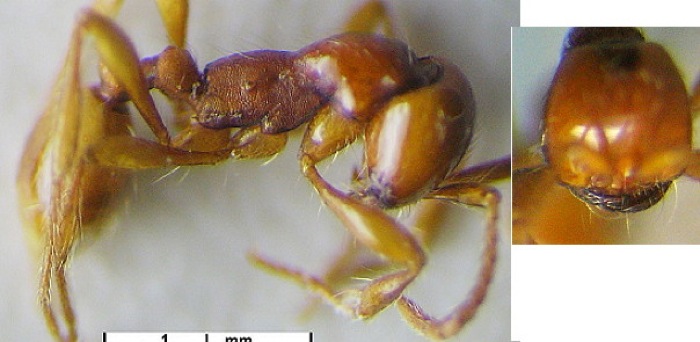 Promesonotal suture
vestigial to absent, usually the latter but very rarely a faint
transverse line is visible in dorsal view; suture never impressed nor
flexible; antenna with 8-10 segments; spiracle of postpetiole behind
midlength of tergite; gastral spiracles circular; first- gastral
segment with a narrow neck-like constriction behind the articulation
with the postpetiole. Promesonotal suture
vestigial to absent, usually the latter but very rarely a faint
transverse line is visible in dorsal view; suture never impressed nor
flexible; antenna with 8-10 segments; spiracle of postpetiole behind
midlength of tergite; gastral spiracles circular; first- gastral
segment with a narrow neck-like constriction behind the articulation
with the postpetiole. |
AENICTINAE - one Genus Aenictus |
| -- |  Minute ants, TL
1.3-1.5 mm; antennae 10-segmented, with two-segmented club; clypeus
projecting back between frontal carinae; pale yellow Minute ants, TL
1.3-1.5 mm; antennae 10-segmented, with two-segmented club; clypeus
projecting back between frontal carinae; pale yellow |
MYRMICINAE - one Genus Solenopsis - subkey M |
| 8 | 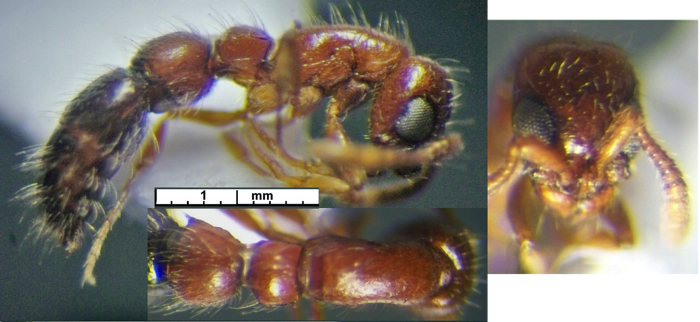 Pygidium transversely flattened or impressed and armed
laterally, posteriorly, or both, with a row of short spines or peg-like
teeth that usually project vertically. Pygidium transversely flattened or impressed and armed
laterally, posteriorly, or both, with a row of short spines or peg-like
teeth that usually project vertically. |
CERAPACHYINAE - one Genus Cerapachys |
| -- | Pygidium transversely rounded, may be very small, not armed laterally or posteriorly with a row of short spines or peg-like teeth. | 9 |
| 9 | 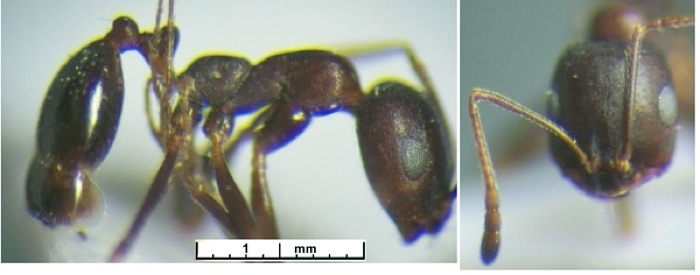 Frontal lobes
present, horizontal to somewhat elevated; the antennal sockets are
always partially or completely covered by the frontal lobes in
full-face view and are never completely exposed; promesonotal suture
usually completely absent; rarely with a vestigial remnant of the
suture in the form of a feeble, transversely arched impression in
dorsal view, but pronotum and mesonotum always fused and immobile with
respect to each other. Frontal lobes
present, horizontal to somewhat elevated; the antennal sockets are
always partially or completely covered by the frontal lobes in
full-face view and are never completely exposed; promesonotal suture
usually completely absent; rarely with a vestigial remnant of the
suture in the form of a feeble, transversely arched impression in
dorsal view, but pronotum and mesonotum always fused and immobile with
respect to each other. |
MYRMICINAE - ten Genera - subkey M |
| -- |  Frontal lobes either
absent or very reduced and vertical; in either case the antennal
sockets are completely exposed in full-face view and are not at all
concealed or covered by the frontal lobes.Promesonotal suture present,
freely flexible; hind tibia with a conspicuous pectinate apical spur;
posterior margin of median portion of clypeus not projecting back
between antennal sockets. Frontal lobes either
absent or very reduced and vertical; in either case the antennal
sockets are completely exposed in full-face view and are not at all
concealed or covered by the frontal lobes.Promesonotal suture present,
freely flexible; hind tibia with a conspicuous pectinate apical spur;
posterior margin of median portion of clypeus not projecting back
between antennal sockets. |
PSEUDOMYRMECINAE - one Genus Tetraponera |
| D | Subkey to Dolichoderinae | . |
| D1 | Petiole squamiform and erect or moderately angled forward | D2 |
| -- | Petiole a low inclined scale with no node | D3 |
| D2 | 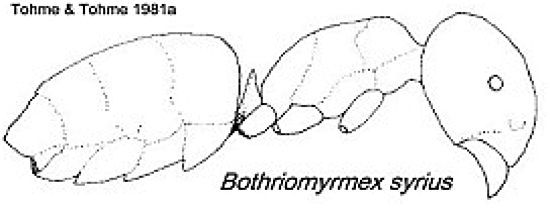 Petiole squamiform;
very small eyes, no ocelli; in full face head with strongly convex
sides; clypeus not incised medially Petiole squamiform;
very small eyes, no ocelli; in full face head with strongly convex
sides; clypeus not incised medially |
Bothriomyrmex |
| -- | 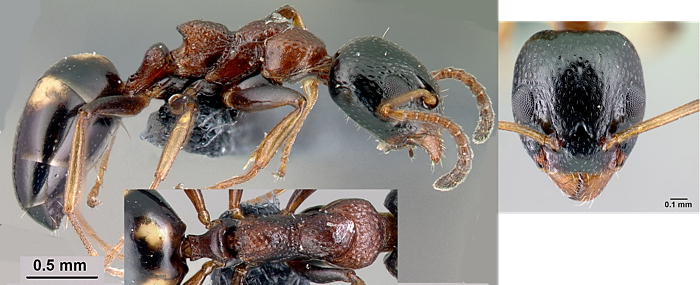 Petiole a thick
scale, angled slightly forward; clypeus impressed medially Petiole a thick
scale, angled slightly forward; clypeus impressed medially |
Dolichoderus |
| D3 |  Propodeal spiracles
ventral and near hind coxae; in dorsal view, gaster with only four
visible segments; the fifth segment facing ventrally; clypeus may be
incised medially Propodeal spiracles
ventral and near hind coxae; in dorsal view, gaster with only four
visible segments; the fifth segment facing ventrally; clypeus may be
incised medially |
Tapinoma |
| -- |  Propodeal spiracles
lateral (but below the dorsum) or ventral, gaster with five visible
segments, anal orifice apical Propodeal spiracles
lateral (but below the dorsum) or ventral, gaster with five visible
segments, anal orifice apical |
Technomyrmex |
| F | Subkey to Formicinae | . |
| F1 | Antennae 11-segmented | F2 |
| -- | Antennae 12-segmented | F4 |
| F2 | 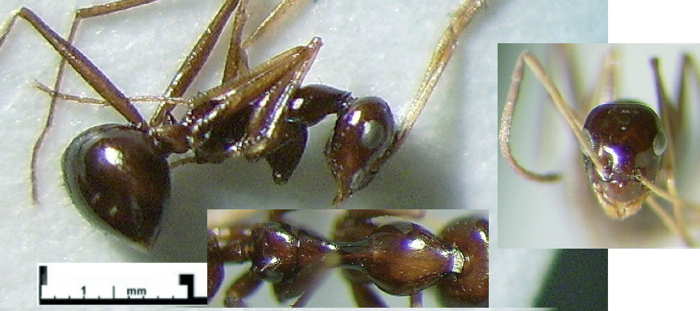 Propodeum armed with
a pair of spines, teeth or tubercles Propodeum armed with
a pair of spines, teeth or tubercles |
Lepisiota |
| -- | Propodeum unarmed, palp formula 6,4 | F3 |
| F3 | 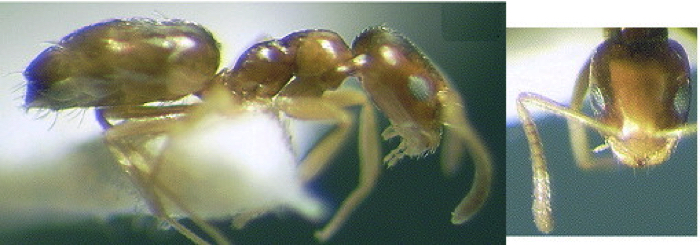 Metanotum distinct Metanotum distinct |
Plagiolepis |
| -- | Mandible
with 5 teeth, when closed mostly concealed by clypeus; dorsum of head
behind clypeus without erect stout setae; eyes set variably around
midlength of head; three ocelli distinct; metatibia with a divergent
pair of large coarse setae on each side, no median spur; anterior face
of gaster with distinct cavity, into which the petiole fits when
alitrunk and gaster in horizontal alignmen |
Tapinolepis |
| F4 | Metapleuron with distinct wide orifice for the metapleural gland; antennal sockets close to the posterior margin of the clypeus | F5 |
| -- | No metapleural gland orifice; antennal sockets well behind the posterior clypeal margin | F6 |
| F5 | 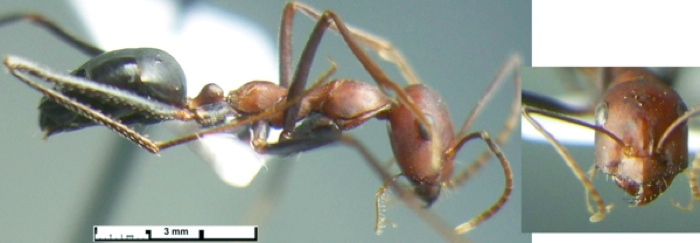 Propodeum with
slit-like spiracle, ocelli present; petiole a stout vertical scale or
node; maxillary palps elongated Propodeum with
slit-like spiracle, ocelli present; petiole a stout vertical scale or
node; maxillary palps elongated |
Cataglyphis |
| -- | 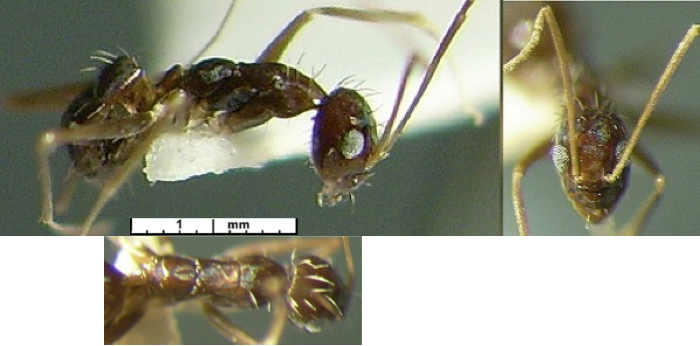 Large conspicuous
eyes, dorsal surface with paired coarse setae; petiole a reduced
anteriorly inclined scale Large conspicuous
eyes, dorsal surface with paired coarse setae; petiole a reduced
anteriorly inclined scale |
Paratrechina |
| F6 | 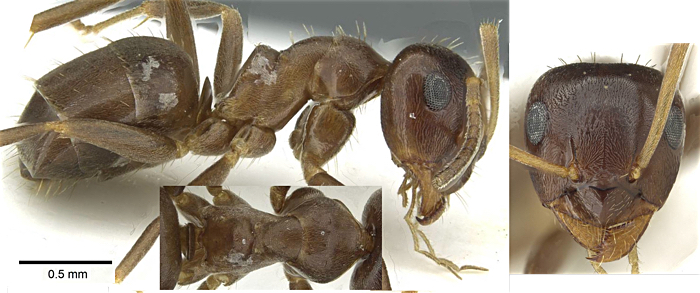 Monomorphic; head
massive relative to alitrunk; alitrunk not conspicuously contricted;
propodeum spiracle round; mesonotum typically convex in profile;
petiole scale prominent, erect and with a symmetrical profile Monomorphic; head
massive relative to alitrunk; alitrunk not conspicuously contricted;
propodeum spiracle round; mesonotum typically convex in profile;
petiole scale prominent, erect and with a symmetrical profile |
Lasius |
| -- |  Monomorphic, petiole
and propodeum armed Monomorphic, petiole
and propodeum armed |
Polyrhachis |
| -- | 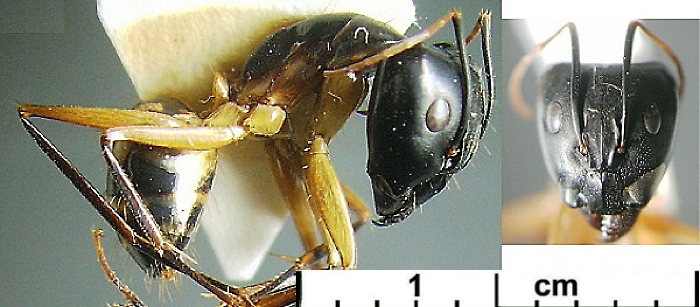 Polymorphic;
propodeum unarmed; petiole an unarmed node or scale Polymorphic;
propodeum unarmed; petiole an unarmed node or scale |
Camponotus |
| M | Subkey to Myrmicinae | . |
| M1 | 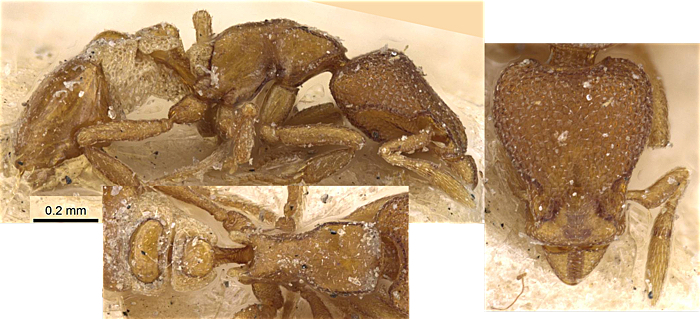 Antennae 6-segmented;
minute TL 1.6-1.7 mm; head distinctively shaped Antennae 6-segmented;
minute TL 1.6-1.7 mm; head distinctively shaped |
Tramp species not definite from Egypt - Pyramica (Trichoscapa) |
| -- | Antennae with 10-12 segments | M2 |
| M2 |  Antennae 10-segmented
with a 2-segmented club; anterior clypeal margin with a single, long,
anteriorly projecting median seta at the midpoint of the margin;
clypeus strongly longitudinally bicarinate; eyes minute; propodeum
always unarmed and rounded; variably polymorphic; small to minute Antennae 10-segmented
with a 2-segmented club; anterior clypeal margin with a single, long,
anteriorly projecting median seta at the midpoint of the margin;
clypeus strongly longitudinally bicarinate; eyes minute; propodeum
always unarmed and rounded; variably polymorphic; small to minute |
Solenopsis |
| -- | Antennae with 11-12 segments | M3 |
| M3 | 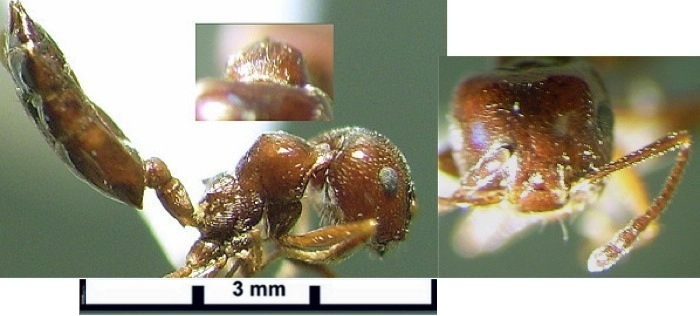 Postpetiole
articulated on dorsal surface of first gastral segment; the gaster in
dorsal view roughly heart-shaped and capable of reflexion over the
alitrunk; petiole dorsoventrally flattened and without a node; antennae
11-segmented. Postpetiole
articulated on dorsal surface of first gastral segment; the gaster in
dorsal view roughly heart-shaped and capable of reflexion over the
alitrunk; petiole dorsoventrally flattened and without a node; antennae
11-segmented. |
Crematogaster |
| -- | Postpetiole articulated on anterior face of first gastral segment; the gaster in dorsal view not roughly heart-shaped, not capable of reflexion over the alitrunk; petiole not dorsoventrally flattened, with a node of some form. | M4 |
| M4 | Antennae with apical 4-5 segments elongated and forming no more than a weak club | M5 |
| -- | Antennae with apical three segments enlarged and forming a distinct club | M7 |
| M5 | 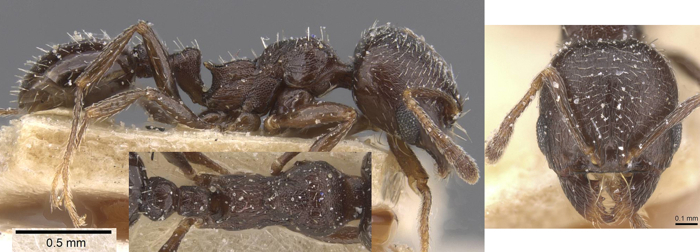 Antennae
11-segmented; eyes set near to mandibles, large and pointed
anteroventrally Antennae
11-segmented; eyes set near to mandibles, large and pointed
anteroventrally |
Oxyopomyrmex |
| -- | Antennae 12-segmented; eyes placed medially and not close to mandibles | M6 |
| M6 |  Ventral surface of
head with a psammophore; head massive and broad, CI > 90; mandibles
massive, their outer margins strongly curved toward the midline;
sometimes edentate; antennae 12-segmented; metasternal process large or
very large, conspicuous; propodeum without spines; polymorphic (TL 4-12
mm); soil nesting, primarily seed-gathering Ventral surface of
head with a psammophore; head massive and broad, CI > 90; mandibles
massive, their outer margins strongly curved toward the midline;
sometimes edentate; antennae 12-segmented; metasternal process large or
very large, conspicuous; propodeum without spines; polymorphic (TL 4-12
mm); soil nesting, primarily seed-gathering |
Messor |
| -- | 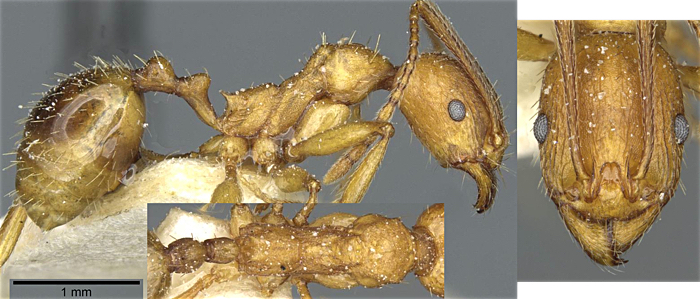 Relatively large; TL 4-6 mm plus many with bizarre ovoid
or elongated necked heads; antennae 12-segmented Relatively large; TL 4-6 mm plus many with bizarre ovoid
or elongated necked heads; antennae 12-segmented |
|
| . |
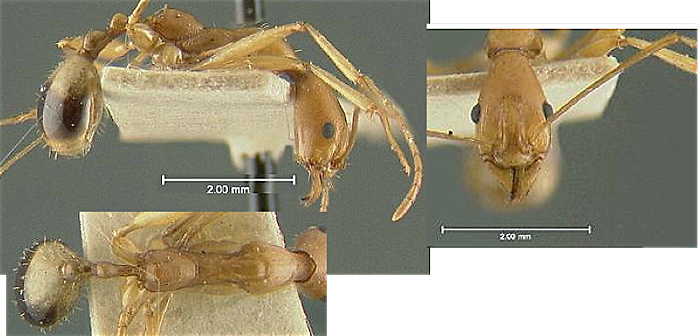 |
Aphaenogaster |
| M7 | 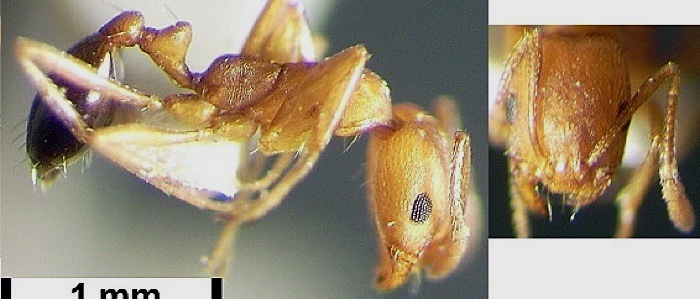 Median portion of
clypeus distinctly longitudinally bicarinate; with a single elongate
seta; midpoint of anterior clypeal margin with a single, elongate seta,
which projects forward over the mandibles and is usually very
conspicuous; median portion of clypeus concave to prominent anteriorly,
usually overhanging the mandibles, weakly to acutely bicarinate;
lateral portions of clypeus not expanded forward nor fused with the
median portion to form a broad, projecting shelf; maxillary palps
usually with 1 or 2 segments, rarely more; mandible with 3-5 teeth
(usually 4); eyes usually quite small, flat and set forward of midline
of face; propodeum usually unarmed, rarely angulate or bidenticulate;
small to minute; found in almost all habitats. Median portion of
clypeus distinctly longitudinally bicarinate; with a single elongate
seta; midpoint of anterior clypeal margin with a single, elongate seta,
which projects forward over the mandibles and is usually very
conspicuous; median portion of clypeus concave to prominent anteriorly,
usually overhanging the mandibles, weakly to acutely bicarinate;
lateral portions of clypeus not expanded forward nor fused with the
median portion to form a broad, projecting shelf; maxillary palps
usually with 1 or 2 segments, rarely more; mandible with 3-5 teeth
(usually 4); eyes usually quite small, flat and set forward of midline
of face; propodeum usually unarmed, rarely angulate or bidenticulate;
small to minute; found in almost all habitats. |
Monomorium and Trichomyrmex |
| -- | Median portion of clypeus without any carinae or with a distinctive median carina | M8 |
| M8 | 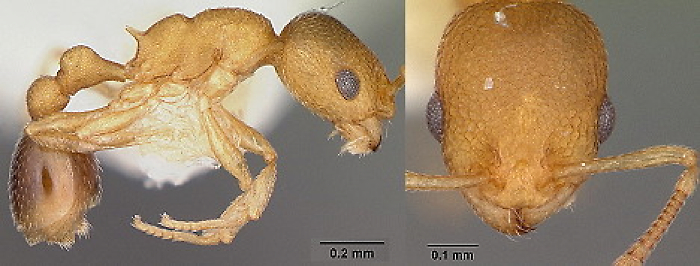 Lateral portions of
clypeus flattened and prominent, fused to the raised projecting median
portion of the clypeus to form a shelf, which projects forward over the
mandibles; frontal lobes separated and median portion of clypeus
broadly inserted between them; antennae 12-segmented; scapes short;
palp formula 5,3; propodeal lobes low and rounded, not connected to
propodeal spines (when present) by broad projecting lamellae; small to
minute, largest ca 3 mm. Lateral portions of
clypeus flattened and prominent, fused to the raised projecting median
portion of the clypeus to form a shelf, which projects forward over the
mandibles; frontal lobes separated and median portion of clypeus
broadly inserted between them; antennae 12-segmented; scapes short;
palp formula 5,3; propodeal lobes low and rounded, not connected to
propodeal spines (when present) by broad projecting lamellae; small to
minute, largest ca 3 mm. |
Cardiocondyla |
| -- | Clypeus not projecting forward over the mandibles | M9 |
| M9 | 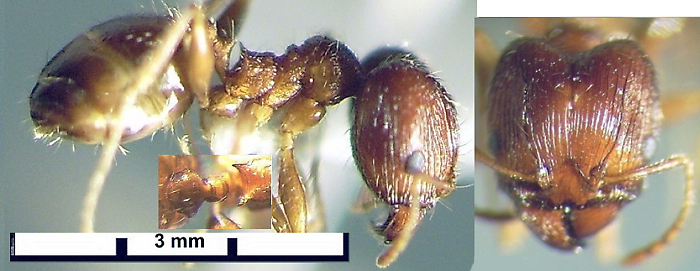 Dimorphic, with
distinctive big-headed soldier morph; antennae 12-segmented with
3-segmented club. Soldiers with mandibles powerfully constructed, armed
with 2 large apical teeth followed by a long diastema and then 1 or 2
(rarely 3) basal teeth; 2 to 4 hypostomal teeth usually present on
posterior margin of buccal cavity; palp formula 2,2 or 3,2 and clypeus
lacking a long, unpaired median seta on the anterior margin. Minors
with moderately elongated triangular mandibles, with apical large tooth
and a series of small teeth ot denticles. Dimorphic, with
distinctive big-headed soldier morph; antennae 12-segmented with
3-segmented club. Soldiers with mandibles powerfully constructed, armed
with 2 large apical teeth followed by a long diastema and then 1 or 2
(rarely 3) basal teeth; 2 to 4 hypostomal teeth usually present on
posterior margin of buccal cavity; palp formula 2,2 or 3,2 and clypeus
lacking a long, unpaired median seta on the anterior margin. Minors
with moderately elongated triangular mandibles, with apical large tooth
and a series of small teeth ot denticles. |
. |
| . |  |
Pheidole |
| -- | Small with near rectangular heads | M10 |
| M10 |  Lateral portions of clypeus raised into a narrow ridge or
wall in front of the antennal insertions; median portion of clypeus
broad, not bicarinate, broadly inserted between frontal lobes; mandible
armed with 2 or 3 enlarged teeth apically, followed by a row of at
least 4 smaller denticles, sometimes more; promesonotum in profile
without a swollen and dome-like outline. Lateral portions of clypeus raised into a narrow ridge or
wall in front of the antennal insertions; median portion of clypeus
broad, not bicarinate, broadly inserted between frontal lobes; mandible
armed with 2 or 3 enlarged teeth apically, followed by a row of at
least 4 smaller denticles, sometimes more; promesonotum in profile
without a swollen and dome-like outline. |
Tetramorium |
| -- | 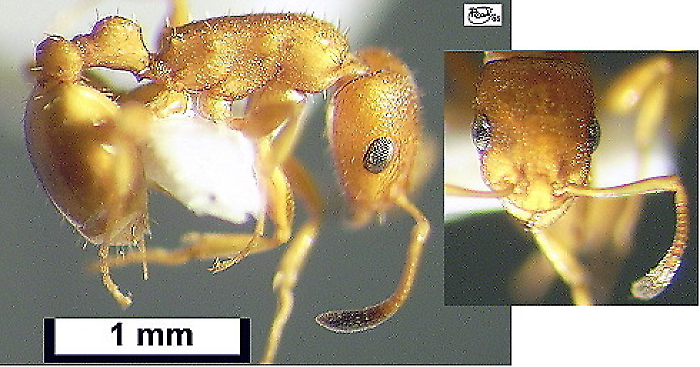 Lateral portions of clypeus not raised; midpoint of
anterior clypeal margin without a single, elongate seta; instead
usually with a pair of short setae, one on each side of the midpoint;
with the alitrunk in profile the mesonotum following the line of the
pronotum; dorsum with short stout erect hairs; 12-segmented antennae;
arboreal and small. Lateral portions of clypeus not raised; midpoint of
anterior clypeal margin without a single, elongate seta; instead
usually with a pair of short setae, one on each side of the midpoint;
with the alitrunk in profile the mesonotum following the line of the
pronotum; dorsum with short stout erect hairs; 12-segmented antennae;
arboreal and small. |
Nesomyrmex |
| P | Subkey to Ponerinae | . |
| P1 | 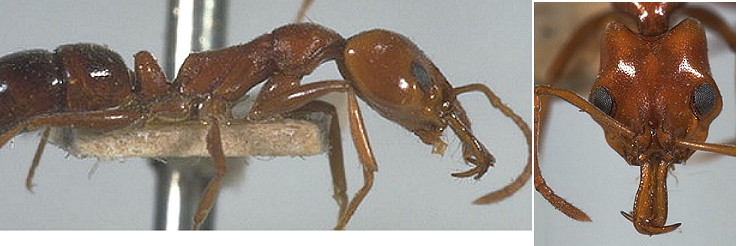 Mandible long and linear, in full-face view inserted in
the middle of the anterior margin of the head, with an apical armament
of 3 teeth arranged in a vertical series Mandible long and linear, in full-face view inserted in
the middle of the anterior margin of the head, with an apical armament
of 3 teeth arranged in a vertical series |
not recorded from Egypt but possibly present - Anochetus |
| -- | Mandible linear to triangular, in full-face view inserted at the anterolateral corner of the head and not armed apically with a vertical series of teeth | P2 |
| P2 |  Ventral apex of hind tibia, when viewed from in front with
the femur at right angle to the body, with a single, large, pectinate
spur; without a second, smaller spur in front of the main spur in the
direction of observation Ventral apex of hind tibia, when viewed from in front with
the femur at right angle to the body, with a single, large, pectinate
spur; without a second, smaller spur in front of the main spur in the
direction of observation |
Hypoponera |
| -- | Ventral apex of hind tibia, when viewed from in front with the femur at right angle to the body, with two spurs, consisting of a large, pectinate spur and a second, smaller spur in front of the main spur in the direction of observation; petiole scale thick and vertical | P3 |
| P3 |  Helcium located very low on the front of the first gastral
segment so that the first gastral segment has a long, vertical anterior
face in profile; basal portion of mandible with a fovea; palp formula
3,3; relatively large eyes (diameter wider than the scape); and a very
deep metanotal suture - subgenus Brachyponera monotypic Helcium located very low on the front of the first gastral
segment so that the first gastral segment has a long, vertical anterior
face in profile; basal portion of mandible with a fovea; palp formula
3,3; relatively large eyes (diameter wider than the scape); and a very
deep metanotal suture - subgenus Brachyponera monotypic |
Brachyponera |
| -- | 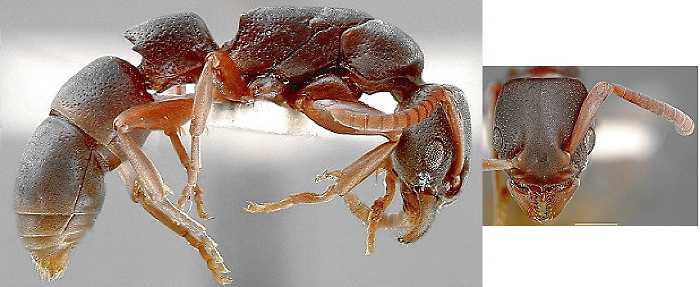 Helcium located approximately at midheight on the front of
the first gastral segment so that the first gastral segment does not
have a long, vertical anterior face in profile; sculpture universally
of fine, dense shagreening with associated larger punctures Helcium located approximately at midheight on the front of
the first gastral segment so that the first gastral segment does not
have a long, vertical anterior face in profile; sculpture universally
of fine, dense shagreening with associated larger punctures |
not recorded from Egypt but possibly present - Platythyrea |
|
©2005, 2006, 2015, 2019 - Brian Taylor
CBiol FRSB FRES 11, Grazingfield, Wilford, Nottingham, NG11 7FN, U.K. |
href="general_key.htm"